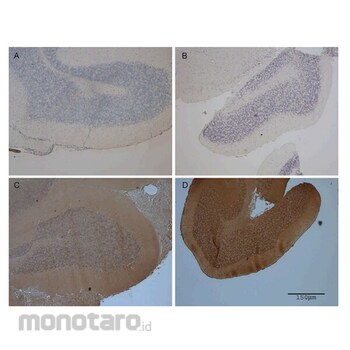Spesifikasi
| Detection Method | Chromogenic |
|---|---|
| Key Applications | Immunohistochemistry |
| Material Size | 50 Reactions |
| Quality Level | MQ100 |
Pilih jenis produk yang diinginkan
| Nomor SKU | Model Number | Masa Persiapan Barang | Harga | Jumlah |
|---|---|---|---|---|
| Loading... | ||||
Informasi Produk
Description
Reactive oxygen species (ROS) have been implicated in pathological processes including cancer,
apoptosis, aging, neurodegenerative diseases, chronic inflammatory diseases, pulmonary diseases, and
cardiovascular diseases (for reviews, see ref. 1-4). Living organisms are continually exposed to potentially
harmful oxygen free radicals that are generated thru normal cellular functions as well as from environmental
factors (1, 5-7). Yet, these reactive molecules are mitigated by the presence of antioxidants and therefore
organisms exist with a delicate balance between oxidants and antioxidants (7-9). During times of oxidative
stress there is an imbalance in favor of the oxidants. The end result of which is that free radicals are able to
attack and modify sub-cellular components including nucleic acids, lipids and proteins (7, 10-12).
Proteins are one of the major targets of reactive species. Oxidation of proteins modifies the side chains of
methionine, histidine, and tyrosine and forms cysteine disulfide bonds (16-19). Metal catalyzed oxidation of
proteins introduces carbonyl groups (aldehydes and ketones) at lysine, arginine, proline or threonine
residues in a site-specific manner (16, 20-22). The oxidative modification of proteins can modulate
biochemical characteristics of proteins such as enzymatic activity (21-23), DNA binding activities of
transcription factors (24-26), and the susceptibility to proteolytic degradation (12, 25-28). While a
relationship between protein oxidation and aging has been suggested (29-31), little is known about the
importance of oxidative modification of individual proteins in the pathophysiology of free radical mediated
processes. Not surprisingly, carbonyl modification of proteins has become a key biomarker for the
identification of oxidative stress.
apoptosis, aging, neurodegenerative diseases, chronic inflammatory diseases, pulmonary diseases, and
cardiovascular diseases (for reviews, see ref. 1-4). Living organisms are continually exposed to potentially
harmful oxygen free radicals that are generated thru normal cellular functions as well as from environmental
factors (1, 5-7). Yet, these reactive molecules are mitigated by the presence of antioxidants and therefore
organisms exist with a delicate balance between oxidants and antioxidants (7-9). During times of oxidative
stress there is an imbalance in favor of the oxidants. The end result of which is that free radicals are able to
attack and modify sub-cellular components including nucleic acids, lipids and proteins (7, 10-12).
Proteins are one of the major targets of reactive species. Oxidation of proteins modifies the side chains of
methionine, histidine, and tyrosine and forms cysteine disulfide bonds (16-19). Metal catalyzed oxidation of
proteins introduces carbonyl groups (aldehydes and ketones) at lysine, arginine, proline or threonine
residues in a site-specific manner (16, 20-22). The oxidative modification of proteins can modulate
biochemical characteristics of proteins such as enzymatic activity (21-23), DNA binding activities of
transcription factors (24-26), and the susceptibility to proteolytic degradation (12, 25-28). While a
relationship between protein oxidation and aging has been suggested (29-31), little is known about the
importance of oxidative modification of individual proteins in the pathophysiology of free radical mediated
processes. Not surprisingly, carbonyl modification of proteins has become a key biomarker for the
identification of oxidative stress.
Feature
Application : The OxyIHC Oxidative Stress Detection Kit contains the chemical & immunological reagents necessary to detect protein oxidation in various tissues from a variety of organs & animal species.
Ulasan Produk
Tidak ada ulasan






















































































































































